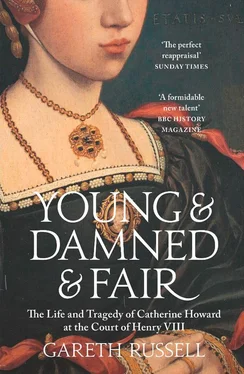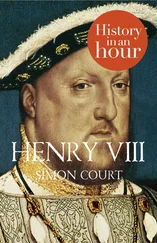Having shown the potential of the stick, Henry VII moved to the carrot. In 1489, Thomas was allowed once again to style himself Earl of Surrey, a subsidiary title previously used as a courtesy by the Duke of Norfolk’s eldest son and heir. Two years earlier, Thomas had an opportunity to gain his freedom from the Tower during the Earl of Lincoln’s ill-fated rebellion against Tudor rule. He wisely chose to stay put to demonstrate that he remained faithful to his king, even while a prisoner – a decision for which he must have given hearty thanks after Henry VII remained secure on his throne and Lord Lincoln ended his life as a sword-pierced corpse.41 When Thomas was eventually released from the Tower, he further proved his fidelity by helping to suppress anti-taxation riots in Yorkshire and deputising for the king’s son, Prince Arthur, who, at the age of three, was understandably considered too young to police the Anglo-Scottish border himself.42 In return for each act of service, another title, another piece of land, another sign of royal favour, was handed back to the Howards. Thomas’s first wife, Elizabeth, became a lady-in-waiting to the new queen, Elizabeth of York, and eventually godmother to the king and queen’s eldest daughter, Princess Margaret.43 The Howard children were allowed to come to court, and the boys were given positions in the royal households.44 The message from the Tudors’ throne was clear, if not always easy to follow. Where Edward IV had turned the Howards into enemies whose only chance of prosperity lay with toppling his lineage, Henry VII had turned them into servitors whose hope lay in doglike obedience.45
Thomas Howard’s tribe of children were expected to do their part in the rebuilding of the family – either through royal service, advantageous marriages, or both. The most spectacular match was that of the family’s heir, young Thomas, who married Henry VII’s sister-in-law, Anne of York; when she died in 1511, Thomas wed Henry VIII’s cousin, Lady Elizabeth Stafford, the younger sister of the Duke of Buckingham.46 The marriage of two of the Howard sisters, Elizabeth and Muriel, to members of relatively ‘new’ families like the Boleyns and the Knyvets, might seem curious given the numerous subsequent accounts of the era that describe them as families of knights or country gentlemen, apparently far removed from the aristocratic pedigree the Howards had built for themselves. However, the idea of a binary of gentry and aristocracy is a misleading modern conceit. The few centuries before Catherine’s birth had seen enormous changes in the personnel of the elite – of the 136 lords who attended Parliament at the end of the thirteenth century, the direct descendants of only sixteen of them were around to perform similar duties at the start of the sixteenth.47 The aristocratic caste was simply too narrow to socialise or marry solely within itself, particularly if it is defined as those in possession of, or the offspring of someone with, one of the five titles of the nobility – in ascending order in England, baron, viscount, earl, marquess, and duke, or their female equivalents, baroness, viscountess, countess, marchioness, and duchess. In everyday social interactions, the nuances of aristocratic etiquette drew little distinction between the children of respected gentry families and those from certain families in the nobility – for instance, the offspring of a viscount, a baron, or a gentleman were not entitled to style themselves ‘lord’ or ‘lady’, unlike those born to a duke, marquess, or earl.
To give an idea of how small the high nobility was as a group, compared to the thousands who thronged the court and enjoyed a privileged lifestyle, by 1523 there were only two dukes, one marquess, and thirteen earls in the combined English and Irish peerages.48 Of those sixteen, fewer than half possessed a title that had been in the family for more than three generations. The idea of being ‘gently born’, meaning into a class of landowners who did not have to till their land themselves in order to generate an income from it, bonded the English upper classes together far more than a distinction between who was technically an aristocrat as opposed to a member of the gentry. Families like the Arundells, who owned 16,000 acres in the south-west, were technically ‘only’ gentry, but they were still referred to as a ‘great’ family by their contemporaries, and like most upper-class clans they benefited from their peers’ tendency to count the maternal ancestry as being equally important as the paternal.49 There was certainly a pecking order, and under Henry VIII it worked in the Howards’ favour, but, as ever, people tolerate in their friends what they deplore in their enemies, and it was often only once people quarrelled over other things that truly vicious hauteur reared its head.50
The Howards’ return to the dukedom they had lost at Bosworth was accomplished after twenty-nine years when, in 1514, Henry VIII restored the title in recognition of Thomas Howard’s leadership of the English forces at the Battle of Flodden. Thomas Howard certainly showed no sense of snobbery towards his sons-in-law, and they seem to have been promoted and patronised alongside his own boys.51 In his old age, those men continued to rise after he effectively retired from public life, spending most of his time, in his family’s words, at the ‘Castle of Framlingham, where he continued and kept an honourable house unto the hour of his death. And there he died like a good Christian prince.’52
At the burial ceremony itself, the priest chose to deliver his sermon on the text ‘Weep not: behold, the Lion of the tribe of Judah, the Root of David, hath prevailed.’53 Tribes, lions, and tenacity spoke to the Howards’ souls. As the padre reached the crescendo of his terrifying homily, mixing panegyric with eschatology, the individual with the eternal, several of the congregation became so unsettled and afraid that they left the chapel. Once the hardier mourners had departed at a more decorous pace, the workmen arrived to begin construction of the duke’s unique monument. From an incarcerated traitor to the king’s right hand for defence of the realm, and paterfamilias of one of the largest aristocratic networks in northern Europe, was an extraordinary trajectory for any life, yet the duke died apparently torn between pride at his accomplishments and concern that in years to come observers would assume the worst regarding his loyalty in shifting allegiance from Edward V to Richard III to Henry VII. To prevent this, his tomb boasted a lengthy carved account of his life, which constantly stressed his service to the Crown, irrespective of its incumbent. Over a year later, long after Edmund had returned to Lambeth, his wife, and their growing brood of children, work on the tomb was complete and Catherine’s grandfather rested in splendour.54
*To have two children with the same name was not unusual in an era with a relatively limited pool of Christian names and a custom for allowing godparents to pick a name at the christening ceremony. The 2nd Duke of Norfolk had two sons called Thomas and two daughters called Elizabeth. The aristocratic custom of a plethora of cosy nicknames arose from necessity’s proverbial role as the mother of invention.
Конец ознакомительного фрагмента.
Текст предоставлен ООО «ЛитРес».
Прочитайте эту книгу целиком, купив полную легальную версию на ЛитРес.
Безопасно оплатить книгу можно банковской картой Visa, MasterCard, Maestro, со счета мобильного телефона, с платежного терминала, в салоне МТС или Связной, через PayPal, WebMoney, Яндекс.Деньги, QIWI Кошелек, бонусными картами или другим удобным Вам способом.











![John Bruce - The Lettsomian Lectures on Diseases and Disorders of the Heart and Arteries in Middle and Advanced Life [1900-1901]](/books/749387/john-bruce-the-lettsomian-lectures-on-diseases-and-disorders-of-the-heart-and-arteries-in-middle-and-advanced-life-1900-1901-thumb.webp)
